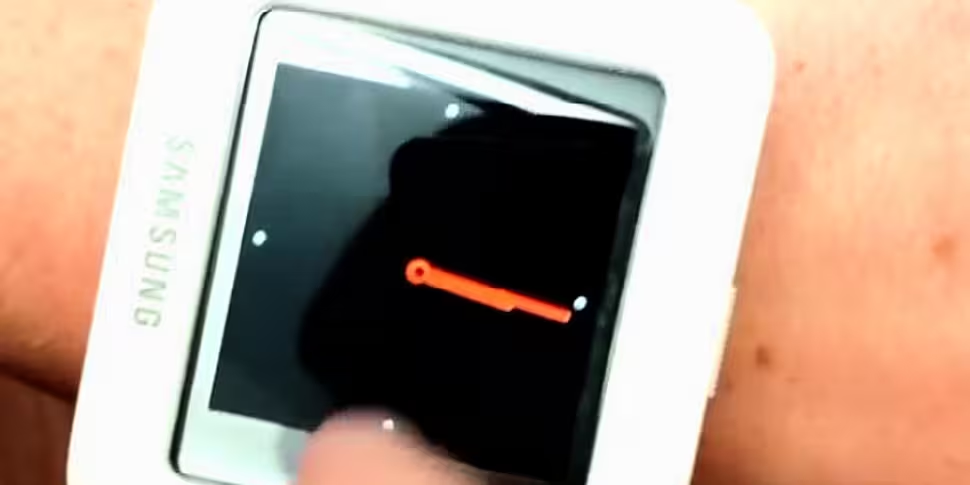Along with the Galaxy Note 3, the Galaxy Gear is Samsung's attempt at getting ahead of the competition for the next generation of smart devices. In the video below, Newstalk's Jessica Kelly gives you a quick look at the Galaxy Gear smartwatch in action:
Want to find out more about it? You can read Brian Byrne's extended impressions of the Gear below.
Look Smart: a glace at Samsung's Galaxy Gear
This article originally appeared in Newstalk Magazine for iPad in October. For more details go here.
In the 1940s comic strip Dick Tracy, the fast-shooting police detective used a ‘2-way wrist radio’ to communicate with his colleagues while he was on the job. 70 years later the iconic piece of kit appears to have become a reality with the announcement of the Samsung Galaxy Gear, but is it as cool as Tracy made his look during all of those gritty investigations?
The Gear is certainly sleeker than Tracy’s, and can do a heck of a lot more, like run over 70 apps, take pictures with a 1.9 megapixel camera, accept voice commands and perhaps coolest of all - make phone calls. Not to mention its 4GB internal memory, enough to store about 500 songs or a few thousand pictures and even a pedometer so it can count your every step. It really does sound incredible.
You see, that’s the thing about the Gear; when you read about it, it seems every bit as fantastic as you hoped it would be. It’s only when you see it in reality you start to wonder if this offering is more a tawdry Back to the Future Part II than a nifty Dick Tracy.
First of all, at 11.1 millimetres thick it doesn’t sound very hefty, but that’s more than a third thicker than Samsung’s latest smartphone the Galaxy S4. Its screen is made from sapphire glass which has proven durability, but is susceptible to daylight glare. And the watch isn’t waterproof; anything more than a light splash of water and the Gear will become a useless brick.
Worse, the Gear isn’t designed to act as a standalone device. It’s more of an accessory, that at the beginning at least, will only work with Samsung’s latest phone-tablet hybrid the Note 3. And those phone calls? You’ll need to connect the Gear to the Note via Bluetooth connection to make them happen, which in turn means you’ll have to carry the Note around in your pocket. Is this beginning to sound just a tad less cool yet?
The countless other issues - like a 25 hour battery life, a glare-prone screen, reported performance lags and an oddly placed speaker in the watch’s clasp that delivers a weak piddle of audio - and you’ll be forgiven for taking a sudden disinterest in what could have been a far superior piece of kit.
Then again, maybe we should forgive even a tech giant like Samsung for tripping over itself a little in its attempt to turn science fiction into living, beeping reality. Only there’s precedent here, and lots of it.
For instance, this summer a start-up company put its own smartwatch into production after raising a record-breaking $10 million (€8 million) on Kickstarter, the popular crowd funding website. Called the Pebble, the watch doesn’t have many of the Gear’s state-of-the-art features, but what it does have is the ability to communicate with both Android and iOS devices, a battery that lasts a week and an affordable price tag of $150 (€110). It’s also about half as thick as the Gear, waterproof and has a low profile design that could make it pass for a regular old dumb watch. The Pebble had shipped 85,000 units by July and the start-up still struggles to keep up with orders, which means there could, in fact, be an audience for the smartwatch - but only when the manufacturers get it right. So what went wrong at Samsung?
Perhaps the company got carried away by Google Glass, Google’s wearable computer that overlays data in your vision by projecting onto a tiny head-mounted display. Ever since Google announced its early adopter programme in February the device has enjoyed an impressive level of hype, but while Google went the way of the Pebble, refining a pre-existing technology as opposed to clumsily slapping a camera on it (Samsung we’re looking at you), it remains to be seen if it will become a successful product in the long term.
Another popular wearable device, the Go Pro, is an all-terrain camera which can be affixed to a range of objects and even parts of your body. It has enjoyed huge sales because it still falls somewhere within the realm of tried and tested devices people have decided they want and need. It is more incremental than experimental.
And this is why, despite its many failings, it is virtually impossible to predict the success of Samsung’s Galaxy Gear. It might fail to sell more than a few thousand units to eager first adopters. Or it could defy all predictions and become as ubiquitous as the smartphone.
Just don’t expect to look as cool as Dick Tracy if you eventually get to wear one.
-Brian Byrne









